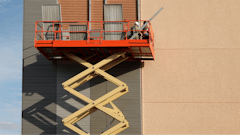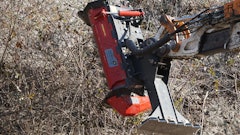By employing effective merchandising techniques at your rental store, you make your selling job easier, according to information from the National Retail Hardware Association. And increasing retail sales at your rental operation can boost your bottom line considerably.
Effective merchandising encourages most customers to serve themselves, thus freeing you to help those who really need your help. In addition, good merchandising does the following:
- Increases your sales per customer. Even when you serve a customer, an attractive merchandising arrangement will stimulate extra sales.
- Raises your total sales. You can only wait on one customer at a time, but many customers can serve themselves at the same time from the displays you build.
Suggestions for success
Merchandising is not some mysterious art only a few possess. Merchandising is daily display activities that almost anyone can do if he or she works at it. Effective merchandisers:
- Put attractive displays, provided by manufacturers and wholesalers, to work for them.
- Use effectively the many point-of-sale pieces he receives.
- Displays related merchandise together for increased impulse sales.
- Features all advertised and promoted items.
- Ensures that all displays are neat, well-stocked and accessible to customers.
- Prices all items consistently. Updates all prices when they change. Makes sure the store is as competitive as possible.
- Allocates space to each department in line with that department's sales.
- Identifies all departments with signs or attractive decor or both.
Relating space to volume
For maximum sales, the amount of space a department occupies should relate to the volume the department generates. Keep in mind you should display what your customers are interested in.
The only way to know how much space you should allocate is to routinely check the store's record of sales per square foot for each department.
The space a store allocates to a department must change constantly. The seasons affect all departments to a greater or lesser degree. The most profitable businesses allocate high-traffic areas to seasonal merchandise, regularly changing the display with the seasons.
Make it effective
Good merchandising is not simply an attractive display. Merchandising, to be effective, makes the entire showroom inviting. No store is well merchandised until all areas of its salesfloor are appealing and easily accessible to shoppers. Effective merchandising demands:
A well-planned salesfloor. Assign every department a specific display area.
Fixtures and accessories designed for the merchandise they display. Stores waste space and lose sales per square foot when they do not use the correct shelf profile and accessories for each merchandise category.
Adequate aisle space. The best display loses selling power if merchandise blocks the aisles and shoppers cannot reach it.
Inviting displays. A display is more than merchandise on a fixture. The items must be clean, the display complete (which means you have to restock the fixture regularly) and the backup stock nearby.
Attractive signs and decor. Signs and decor serve two basic purposes: they create a buying and shopping mood and help direct customers into all areas of your showroom.
End displays
The displays at the end of each gondola run, called feature ends or end caps, are highly effective. The effectiveness, however, depends on:
- The display's attractiveness
- The merchandise's seasonal nature
- Location in the store
- Relationship to surrounding merchandise
- Price
- How well it has been advertised or promoted
- Ease of accessibility
In actual in-store studies conducted by NRHA, some end displays have moved merchandise up to eight times as fast as an identical display just around the corner.
Aisle space
Never crowd the customer by reducing aisle space. There are three basic aisle types in a store:
Main aisles, where major customer traffic is routed, are normally limited to one or two aisles from the front to the rear of the store. Main aisles should be five to six feet wide.
Cross aisles, that feed from main aisles to each side of the store, are normally four to five feet wide.
Secondary aisles run from main and cross aisles into all parts of the store.
Display related merchandise on both sides of an aisle, rather than around a gondola where the customer can see only half the merchandise at a time. Cross-aisle merchandising makes many department's stock seem more complete.
Shelf space
Shelf space is wasted when a store:
- Overstocks one item while understocking another
- Fails to refill bins or shelves when the basic stock is reduced
- Stocks the same items in several places
- Uses the wrong shelf profile
- Does not relate shelf space to customer demand fluctuations
It's more effective to merchandise vertically. That is, display similar goods up and down, on perfboard and shelves, rather than stretching them out along a gondola. The customer can stand in one spot and pick what he wants. The display is more attractive and it's a lot easier to reorder and restock.
Wall-fixture profiles
Although the shelf profile is only one element in effective display, it's an important one. The way the shelf is placed on the fixture is only one element in successful merchandising. How you arrange the merchandise on the shelves is also important. Three quick tips:
- Show as much as possible. Most large stores try to avoid backroom stock.
- Display the most profitable items between belt and eye level.
- Never display a single item. Use the "good, better, best" approach so the customer has a choice of quality.
Adjust the shelves to the merchandise they display. If they are too far apart you waste space and the showroom looks understocked. If shelves are too close together or not set back properly, they customer can't see merchandise on the lower shelves without bending over.
Some general display tips include: First, use a pyramid profile with the widest shelves at the bottom. This lets the customer see the most merchandise. Shelves the same width, however, are best to mass display items of the same size and shape.
Second, never place shelves so close together that the top shelf hides binned or boxed merchandise on the lower shelves. Shelves are for display - not storage. And no top shelf should ever be wider than those below except on a sidewall or gondola over six feet high where the shelf is in fact, more for storage than for display.
Significant signage
A good point-of-sale display might not audibly ask for the purchase, but if done well, it will stimulate extra purchases. An effective point of sale will:
- Attract the customer's attention
- Identify the item or service offered
- Describe what the item will do for the customer
- Give the price and any savings
Departmental signs are different from point-of-sale signs. They should be a regular part of your merchandise arrangement. They help any store, but they are essential on any showroom that is 5,000 square feet or larger.
In summary
To help you remember some of the basic rules of effective merchandising, here is a list of the main points:
- Display slow-moving and low-priced items farthest from the customer's reach.
- Always use prime display space for high-demand, seasonal, impulse or promtional items.
- Use point-of-sale signs to call attention to hot items in each department.
- The best-selling height on any display is between eye and belt level.
- Action, light and color attract attention to any display.
- No display is fully effective or complete until the merchandise is priced. And not only must the items be priced, but the prices must be consistent.
- If feature displays do not blend with other displays around them, they may repel rather than attract.
- Keeping displays neat and well stocked is one of the most effective "tricks" in merchandising. The last thing you should do every night or the first thing you should do every morning is move packages to the front of the shelf; make your displays look full and neat.
Take it easy
An effective showroom is not attained, it's maintained. Since the merchandise you sell and the market and the customers you serve change continuously due to changing needs and interests, it's obvious that you must remerchandise your showroom often. This is a tremendous chore, but when you plan carefully and approach the job in an organized way, you can do it with a minimum of effort. Here are five rules:
- List all improvements to be made.
- Assign a priority for each job to be done.
- Secure the merchandising aids you need to do your job.
- Advise everyone in the store what you plan and how they might be involved.
- Make each remerchandising project a merchandising training session - and practice good merchandising techniques.
Information provided by the National Retail Hardware Association.

























